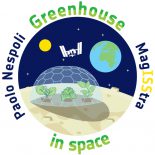ESA has invited schoolchildren aged between 12 -14 years to join the Greenhouse in Space project. This experiment, carried out by the Italian astronaut Paolo Nespoli, consists of growing flowering plants inside two separate small greenshouses set up in the Columbus laboratory and follows their germination over a two-month period. Students on the ground will make the observations of the plants in their own mini greenhouse and compare the results with Paolo’s space experiment, by means of both recorded and live-link activity for educational events.
The 5th year students from CEIP Luis Buñuel, a bilingual school located in the town of Alcobendas, have joined to conduct this
experiment and have yet requested their mini greenhouse kit. On the 17th of February they came to our premises to follow a live event with real time video from the International Space Station, in which the astronaut watered the seeds of the space greenhouse for the first time.
The event was also followed by many students taking part in this exciting educational initiative from different schools all over Europe. They asked interesting questions to the astronaut like ‘how oxygen is generated on the ISS’ or ‘how many times do they have day and night at the ISS’ amongst others. The most stunning moment for our young science enthusiast visitors was Paolo’s demonstration about microgravity, when he made a big water drop to float in front of the camera before ending up in his mouth.
Click on this link to watch the streaming video for this activity.
The experiment impacts

Growing plants in space will be crucial for the astronauts of the future. When flying to Mars or even further, it will be necessary to produce fresh food onboard and become partially self-sufficient. Setting up greenhouses on the Moon, Mars or other planetary bodies will also be an important part of future exploration missions.
Greenhouses also provide oxygen and bring some life to the bleakness of space. Caring for plants is a good way to maintain memories of Earth and an enjoyable way to pass time during the long and possibly boring interplanetary cruise.
Ext. Source: ESA news – A greenhouse in space
The MagISStra mission

MagISStra is the third six-month stay by a European astronaut on the Station, a fascinating mission pursuing the ISS triple goal: bringing the benefits of space science, technology and education from space back to Earth.
Nespoli will contribute to the scientific exploitation of Europe’s Columbus laboratory by carrying out an intensive programme of experiments, ranging from radiation monitoring to visual perception studies, which it is worth mentioning ESA’s novel 3D camera that will show unprecedented images of the ISS.
Ext. Source: ESA MagISStra Press Kit (pdf 5.95 MB)



